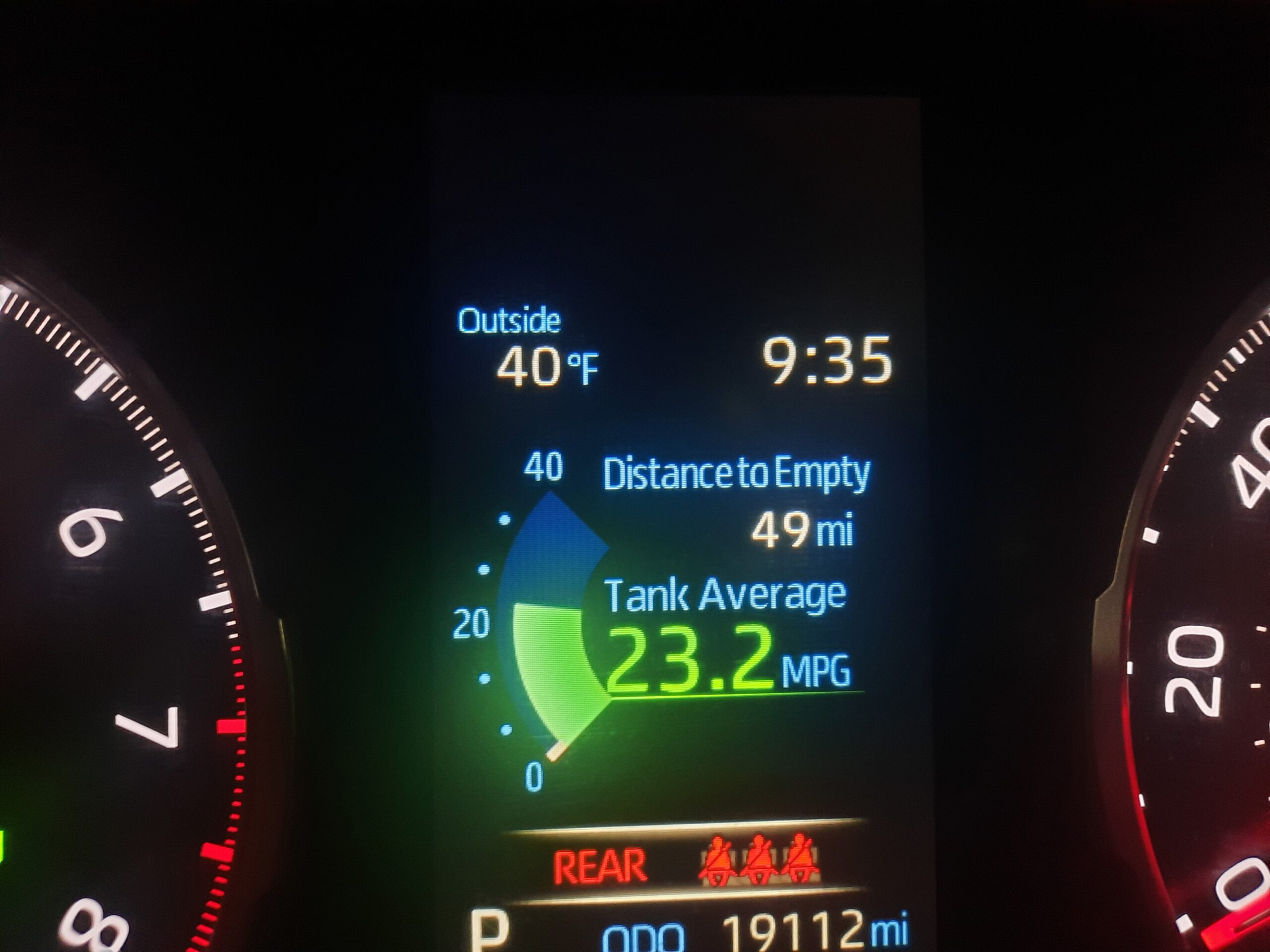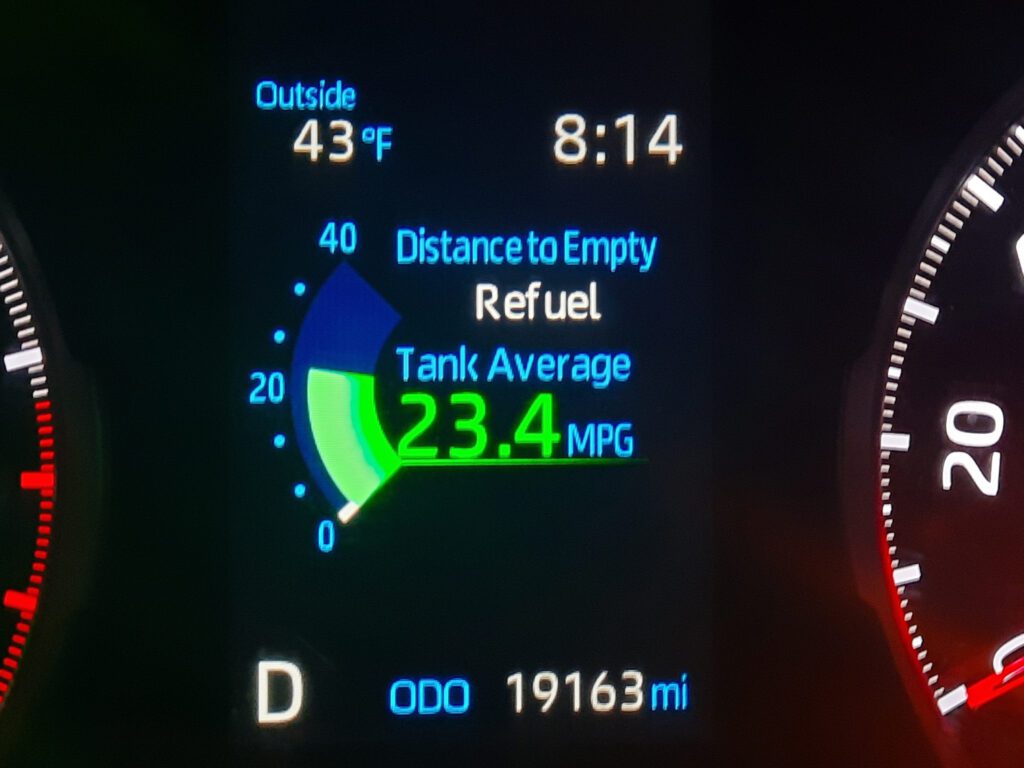The Toyota RAV4’s “Distance to Empty” Display: Explained
Have you ever pushed the gas gauge to the limits, wondering how much further you could drive without running out of fuel? With the RAV4’s “Distance to Empty” display, you’ll know how much further you can drive.
In this guide, I advise you on how to use the Distance to Empty information. I also show you some reasons why this information shouldn’t be relied upon.

What It Means
For many decades, cars have been equipped with a low fuel warning light. When the fuel gauge gets to a certain level, the light comes on to tell you that you need to stop at the fuel station.
On newer vehicles, there’s also a display showing the distance remaining you need to refuel. With the Toyota RAV4, this data is found on the multi-information display.

It counts down the mileage until it hits zero. At this point, the display shows a “Refuel” warning indicating that the RAV4 is nearly out of gas.
How to View
If you haven’t found the distance to empty display yet, I’ll show you. Normally, it should be listed directly in front of you on the dashboard display. However, sometimes you need to flip through a few screens to view it.
Here are some basic steps to view the distane to empty display:
- With the left and right arrow keys, select the leaf icon, known as the Driving Information Display
- Press the up and down arrow keys to view different driving information display
Check out this video for a demonstration:
How It Works
The distance to empty feature can’t figure out the exact amount of miles you’ll get on the remaining fuel. Instead, it displays what’s in the fuel tank divided by the estimated MPG. The miles per gallon figure depends on your typical driving habits.
Overall, this figure is helpful in determining when you will get critically low on fuel. The exception is if you deviate from your typical driving habits. As an example, if you drive on the highway most days, the RAV4 sees high MPG. If you suddenly hit a hilly area with lots of traffic lights, the system might think you have more miles to drive than you do. You may notice that your distance to empty number drops suddenly. You could run out of fuel sooner than expected.
This has happened to me personally, which almost left me stranded.
After driving for hours on flat highways in Utah, I had about 35 miles left on my distance to empty display. However, I had to ascend a mountain several thousands of feet, with the gas station at the top.
During the 5-mile ascent, my distance to empty display went from 35 miles down to 0! I still had another mile before reaching the gas station.
This happened because my MPG was very high from the highway driving, then I got very low gas mileage during the ascent.
Here’s Why the Measurement is Misleading
Should you rely on the distance to empty measurements? RAV4 owners find it to be slightly misleading.
The low fuel level warning light comes on with anywhere from 15 to 35 miles left on the distance to empty indicator. Based on the 5th generation (2019+) RAV4 owner’s manual, that means there are 2.2 gallons of fuel left in the gas tank.
With this information in mind, there should be between 1.7 and 2.0 gallons of fuel in the tank when the distance to empty indicator hits zero. When the display gets to zero, you’ll see a “Refuel” message.

Because this measurement isn’t looking at the mileage left until the tank becomes completely empty, it can be misleading. With nearly 2 gallons of fuel still left in the tank when it indicates empty, the RAV4 should drive another 45 to 75 miles.
Why does Toyota do this? It’s a safety precaution keeping drivers from running out of fuel. It’s also not good for the fuel system to run low continuously. I will discuss more on that in a minute.
How to Reset
You don’t need to do anything to reset the distance to empty indicator.
Instead, this indicator resets automatically whenever the car is refueled. Once new gas is added to the tank, the distance reflects the new mileage.
There’s one exception. If only a small amount of fuel is added, the vehicle may not immediately detect the change. In this case, the distance to empty display may not update. To change this, add more fuel or wait for it to recalculate over time.
How Far a RAV4 Can Go on Empty
Considering that there should still be a bit less than 2 gallons of fuel in the tank when the display hits zero, you may be able to drive another 45 to 75 miles. I don’t advise you to do this, however.
Running the RAV4 low on fuel can lead to multiple issues. Here are just a few reasons why you shouldn’t drive on empty.
- Creates damage to the fuel pump
- Fuel filter can malfunction
- Could run out of gas, leaving you stranded
- Could cause an accident if you run out of fuel
Ideally, you want to keep ¼ tank of fuel in the RAV4 at all times. Not only does this protect the valuable fuel system parts, but it also ensures you have fuel in case of an emergency. For example, if you get stuck in traffic in the middle of winter, you don’t want to run out of gas.
(Source)
Frequently Asked Questions
Keep the Motor Running on Your RAV4
The distance to empty display is a valuable source of information. It helps you gauge how many more miles can be driven before the tank needs to be filled up. However, it’s not something that should be entirely relied upon.
Use the information you see to judge when it’s time to fill up, but don’t let the RAV4 run empty. It’s best to keep the tank filled a minimum of ¼ or more, so you shouldn’t ever see the low fuel light come on. With a little foresight, you keep your RAV4 in its best operating condition.
